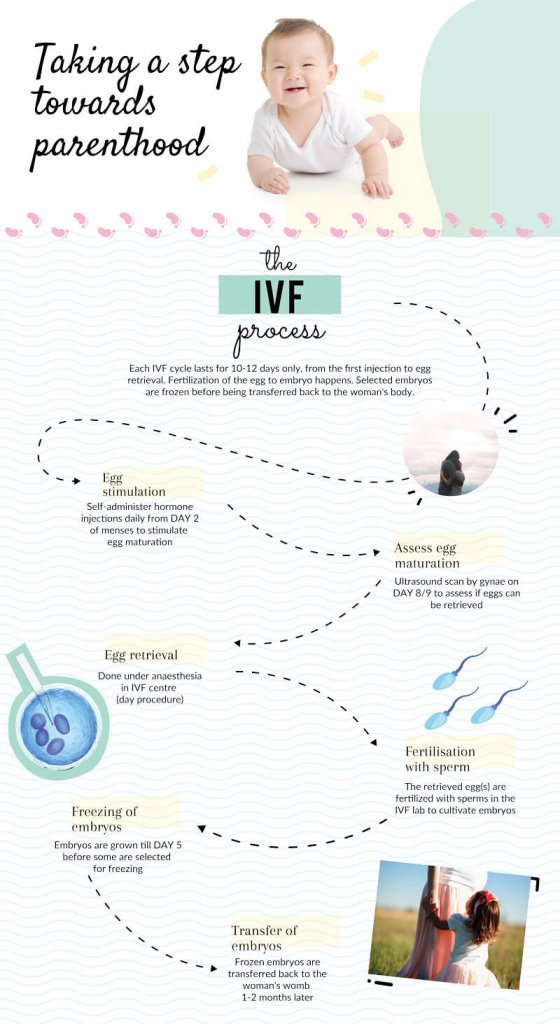In-Vitro Fertilisation, known as IVF in short, is an assisted reproductive technique (ART) that is often the last glimmer of hope for couples trying to conceive. While it sounds very complex and intimidating for many, it is generally a very safe procedure. Also, it is only recommended after a proper fertility assessment has been conducted by the fertility specialist.
In-Vitro Fertilisation (IVF)
What You Should Know About In-Vitro Fertilisation (IVF)

1. What is the IVF Treatment Process Like in Singapore?

IVF literally means that fertilisation of the woman’s egg happens outside the human body, as compared to natural conception where the sperm fertilises the eggs in a woman’s womb.
Since the sperm and egg meet outside the body, the IVF process will consist of steps taken to retrieve the egg from the woman and the sperm from the man before the sperm and egg meet in a test-tube for fertilisation to happen. Here’s what a couple goes through during the IVF process:
Step 1: Egg Stimulation
The ovaries are first stimulated using an injection with hormones to produce many eggs at once. The injections can be administered by the patient at home, and starts from Day 2 of the menstrual cycle. It takes 10-12 days from the first injection to the time the eggs are retrieved.
Step 2: Assess Egg Maturation
On Day 8/9 of the cycle, the gynaecologist then performs a simple ultrasound scan to check on the maturity of the stimulated eggs.
Step 3: Egg Retrieval
Once a mature egg is observed, it will be extracted from the woman in a day surgery procedure within the fertility centre in Singapore. This procedure is done under anaesthesia. From the first injection to the retrieval of eggs, the duration is approximately between 10- 12 days.
Step 4: Fertilisation with Sperm
The collected eggs and sperms are fertilised in an IVF laboratory by an embryologist on the day of the egg retrieval. Eggs that have been successfully fertilised are known as embryos. These embryos are then grown for 3 to 5 days, during which the abnormal or unhealthy ones are weeded out. An embryoscope may be used to create a time-lapse video over these 5 days to monitor the development of the embryos in the IVF laboratory.
Step 5: Freezing of Embryos
Embryos that are determined to be optimal are then frozen, before being transferred back into the woman’s womb 1-2 months later. The woman will need to take hormone tablets daily before the transfer is performed.
Step 6: Transfer of Embryos
The embryo will be transferred back into the woman’s womb in a simple procedure that is done in the IVF centre. This transfer process will take around 20-30 min and does not require anaesthesia.
Step 7: Check if IVF is Successful
2 weeks after the transfer of the embryo into the woman’s womb, a pregnancy test (blood test) will be done to check if the woman has successfully conceived.
What a Woman Undergoes for IVF
- Self-administer hormonal injections daily from Day 2 of menstrual cycle to stimulate the maturation of eggs.
- On Day 8 or 9 of the cycle, a visit to the gynaecologist for a first ultrasound scan to assess if the eggs are ready to be retrieved (if not, a second ultrasound 2-3 days later might be required).
- Retrieval of the eggs from the woman under anaesthesia. This is done in the IVF centre using a probe with a needle attached and typically takes 20-30min while the woman is asleep.
- Transfer healthy embryo(s) back into woman’s womb.
What a Man Undergoes for IVF
- Collection of Sperms
What are the Chances of Pregnancy with IVF?
The success rates of IVF range between 50-60%. In recent years, freezing the embryos before putting them back into the woman’s body has been found to increase success rates of IVF. The underlying theory is that embryos that have survived the freezing process are more resilient and therefore have a higher chance of resulting in pregnancy. Transferring frozen embryos is now commonly practised by many IVF clinicians.
“Is IVF Really Meant for Older Women?”
Age is one of the most critical factors that affect the success of the IVF procedure. While doctors observe that most women coming for IVF are in their late 30s to 40s, the use of IVF is not limited to older women. Younger women, who want to conceive faster or who have blocked fallopian tubes can undergo IVF earlier to help them conceive.
“ONE or TWO Embryos?”
In Singapore, a maximum of 2 embryos can be transferred at any one time in most situations. If 2 embryos were transferred and the woman gets pregnant, chances of her delivering twins are less than 10%.

4. How do We Prepare for IVF?
Emotional Tenacity
While most of the procedures in IVF are performed on the woman, IVF is still very much a couple’s journey. The husband plays an important role in providing encouragement and support, as the medications can sometimes result in mood swings in his wife. Both husband and wife also have to be emotionally prepared for the IVF outcome since a success rate of 50-60% means chances of success and failure are almost the same.

Lifestyle Modification
Before you start on IVF, it is important to have a good diet and also abstain from smoking and drinking. Stress should be significantly reduced and the need for long-term medications might need to be reviewed (depending on your doctor’s assessment). The woman should also try to not fall sick during the period leading up to her IVF cycle; in some cases, the IVF procedure will be postponed if the woman falls ill.
Also, after the embryo transfer, the woman should refrain from exercise or strenuous activity while waiting to test for her pregnancy.

How much does IVF Treatment Cost in Singapore?
Financial Planning
In Singapore, IVF can be performed in the public and private healthcare sectors, though the waiting time often tends to be shorter in the private sector. The average cost of an IVF cycle in the private sector would be approximately $13,000 to $15,000. This includes:
- Fees charged by the IVF laboratories (between $8000- $10,000)
- Medication fees (between $2000- $5000)
Singaporeans can make use of their Medisave to pay for the cost of IVF in any centre (private or public), subject to the withdrawal limits, stated below:
- 1st Cycle – $6,000
- 2nd Cycle – $5,000
- 3rd & Subsequent Cycles – $4,000
A lifetime Medisave withdrawal limit of $15,000 per patient for ART applies as well.
Get More Information on Subsidies and Funding for Singaporeans
5. Who Can I Consult for IVF Treatment in Singapore?
There is a specialized group of male and female gynaes in Singapore, who are IVF-accredited, that can perform IVF for you. These gynaecologists have gone through rigorous training and are mandated to perform a stipulated number of IVF procedures under supervision before they are accredited as IVF clinicians.
However, the fertility journey does not start with In-vitro Fertilisation (IVF). These fertility specialists will conduct a detailed fertility assessment to determine the causes of infertility before recommending the most suitable fertility treatment option unique to your condition. Always keep an open mind and most importantly, seek help early to maximize your chances at pregnancy.
Consult an IVF Specialist at SMG Women’s Health, Singapore
What is IVF?
In-Vitro Fertilisation, known as IVF in short, is an assisted reproductive technique (ART). IVF literally means that fertilisation of the woman’s egg happens outside the human body, as compared to natural conception where the sperm fertilises the eggs in a woman’s womb.
What are the chances of pregnancy with IVF?
The success rates of IVF range between 50-60%.
How many IVF cycles do people usually need?
Not more than 3-4 IVF cycles are required, in fact, on average, most couples get pregnant in less than 3 cycles.
Can I implant more than 2 embryos for my 1st IVF?
The maximum number of embryos is 2 per IVF cycle. There are requirements for a couple to meet before more embryos can be implanted.
How can I prepare people around me when doing IVF?
IVF is a journey that requires plenty of commitment and sacrifice from a couple, especially for a lady. This is why it is important to have supportive people around you throughout this time that can help you out or look for alternative help where needed.
What kind of lifestyle should I adopt while planning for IVF?
Couples should adopt a healthy lifestyle. This includes getting your pre-existing health conditions corrected before starting on IVF. Couples are also encouraged to stop smoking and drinking alcohol.
For those planning on taking traditional medicine, do consult your doctor before doing so.
Fertility
- Fertility Assessment (Male & Female)
- Ovulation Induction
- Intra-Uterine Insemination (IUI)
- In-Vitro Fertilisation (IVF)
- Andrology & Male Infertility
- Gynae-Laparoscopic (Keyhole) Surgery

Need to consult a fertility specialist?
Our female fertility doctors are located at central locations in Singapore for easy and quick access.


